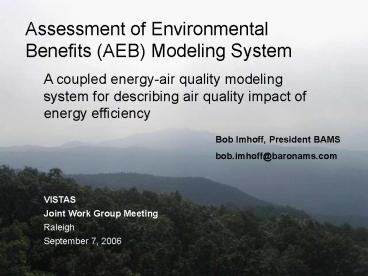Assessment of Environmental Benefits AEB Modeling System - PowerPoint PPT Presentation
1 / 26
Title:
Assessment of Environmental Benefits AEB Modeling System
Description:
Buck. Gas Turbine. Natural Gas Interruptible. 2.0813. 10.4100. 8.3287 ... Buck (tons/season) (tons/season) (tons/season) VST-3-4E0L. Base. Reduction. Rowan/NC ... – PowerPoint PPT presentation
Number of Views:38
Avg rating:3.0/5.0
Title: Assessment of Environmental Benefits AEB Modeling System
1
Assessment of Environmental Benefits (AEB)
Modeling System A coupled energy-air quality
modeling system for describing air quality impact
of energy efficiency
Bob Imhoff, President BAMS bob.imhoff_at_baronams.com
VISTAS Joint Work Group Meeting Raleigh September
7, 2006
2
Funding
- Oak Ridge National Laboratory (ORNL) Energy
Efficiency and Renewable Energy Program
3
ASTEC Team Members
- National Environmental Modeling and Analysis
Center (UNCA) - Prime Sub-Contractor and Project Management
- CMAQ Modeling Data Transfers and Visualizations
- Baron Advanced Meteorological Systems
- Principal Investigator Bob Imhoff
- Emissions processing and guidance of CMAQ
modeling - Oak Ridge National Laboratory (ORNL)
- Preparation of power plant database
- Power dispatch modeling in support of CMAQ
modeling runs
4
BAMS
- Spun out of MCNC Environmental Modeling Center
2003 - National Numerical Model 5-day Met, Ozone and
PM2.5 Forecasts - State Air Quality Forecasters
- Television Stations
- WxWorx (Marine, Aviation, Surface Transportation)
- Advanced Systems
- Hydrological forecasting systems
- Meteorological forecasting systems
- Research Development
- NASA assimilation of satellite data into AQ
forecasts - EPA CMAQ AE3 and SMOKE into WRF-CHEM
5
Haze Forecast for September 7 2006www.hazecast.or
g
6
Assessment of Environmental Benefits Modeling
System (AEB) Objective
- Obtain SIP Credit for Air Quality Benefits of
Energy Efficiency Technologies - How do we make the case?
- Link together accepted models using new S/W tools
and new methods - ORCED
- SMOKE
- CMAQ
- Follow USEPA Guidance to ensure emission
reductions will be Quantifiable, Surplus,
Enforceable, Permanent
7
AEB Modeling System - overview
8
VISTAS Essential Research Partner
- AEB relies on VISTAS Datasets
- Quality-assured meteorological data
- Quality-assured future emissions inventory (Base
D) - Quality-assured base case CMAQ output
- Relationship to VISTAS
- Opportunity for testing assumptions,
methodologies, and obtaining guidance on
prospective research products - Collaboration
- Ongoing technical assistance
9
QA Comparison of Modeled Hourly PM2.5 Data Cell
on Cell Regression
(90,42)
(112,32)
Slope 0.9018
Slope 0.8911
10
Time Series of O3 Difference,V-NC8EE0LL
Annual DMAX occurred on July 17, 2002
Most maxima occurred at (118,49)
11
Power Dispatch Modeling (ORCED)
- Simple definition How much power from which
units at what time - Why important
- high voltage transmission enables movement of AC
power over long distance, resulting in
significant import/export - thus demand reductions, emission reductions, and
air quality benefits are not coincident
temporally or geographically - Working back from desired end product
- Air quality benefits spatially- and temporally-
resolved - Emissions reductions similarly resolved
- Which units in the domain affected by an EE
program - Predict power plant dispatch
- Least cost basis typically, contingent on
Operations
12
Capacity for Southeastern Electric Reliability
Council (SERC) Sub-region of VACARSouthernTVA
Green natural gas Red coal Brown oil Purple
nuclear Blue hydro Tan renewable Area of
circle is proportional to generation capacity
Power-gen Pictogram originated by Stan Hadley of
Oak Ridge National Lab
13
USEPA Guidance on SIP Credit for EERE Emission
Reductions 8/5/04
- Estimate the energy savings
- Reduction estimated by the states with tool like
CACPS - Sens Matrix indicates emissions, AQ impact for
range of reductions - Convert the energy impact into emissions
reductions - State-of-the-science approach using power
dispatch model, ORCED, developed by Oak Ridge
National Lab - Determine the impact on air quality
- State-of-the-science approach using SMOKE
emissions processor and multiple runs of CMAQ - Provide a mechanism to validate effectiveness
- Deceleration of demand, and decrease in monitored
concentration of Ozone and PM2.5 would indicate
effectiveness
14
AEB Contribution to meeting Guidance
- Estimate the energy savings
- Reduction estimated by the states and Sens Matrix
approach shows AQ impact for range of reductions - Convert the energy impact into emissions
reductions - State-of-the-science approach using power
dispatch model, ORCED, developed by Oak Ridge
National Lab - Determine the impact on air quality
- State-of-the-science approach using SMOKE
emissions processor and multiple runs of CMAQ - Provide a mechanism to validate effectiveness
- Deceleration of demand, and decrease in monitored
concentration of Ozone and PM2.5 would indicate
effectiveness
15
Relationship of AEB Sensitivity Matrix to Clean
Air and Climate Protection Software (CACPS)
16
EUI Access Screens
17
Email Notification
18
Downloaded Products
19
Product Access Through Web Page
20
Changes to SO2 Emissions
21
Changes to NOx Emissions Detail
22
Changes Max 8-hr Avg Ozone
August 8
August 9
23
Changes in PM2.5
65 ug/m3 24-hr average
15 ug/m3 annual average
24
Animation for SeptemberNC 8 demand reduction
25
Linkage Between Energy Modeling and Air Quality
Modeling with AEB
SM
Sensitivity Matrix captures the intelligence of
CMAQ modeling runs with pollutant-specific,
gridded, hourly sensitivity factors. Expresses
the modeled sensitivity of emissions and the
ambient air in response to changes in power
demand Principal benefit states tool for
characterizing emissions and air quality benefits
from EERE technologies / programs.
26
Summary Uses of the AEB Modeling System
- Software tools are ready to be used, and are
directly applicable to attainment demonstration
modeling in North Carolina, Tennessee, Georgia - AEB provides the policy research community an
opportunity to study the linkage between power
consumption and air quality - States can use this system of analysis to bolster
their weight of evidence arguments in modeling
demonstrations - Modeling system developed to be consistent with
USEPA August 5, 2004 Guidance emission
reductions may be creditable for SIP purposes
Questions and comments to Bob Imhoff Baron
Advanced Meteorological Systems
(BAMS) bob.imhoff_at_baronams.com































